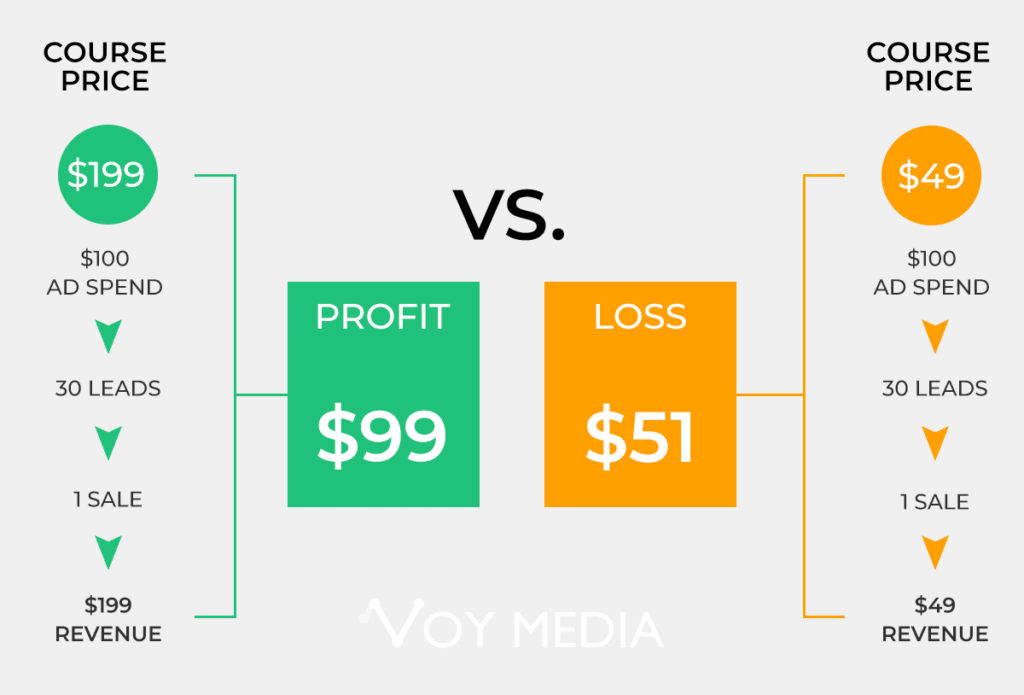

Welcome, online course creators! Are you contemplating the crucial question: “How much should I charge for an online course?” You’re embarking on an exciting journey where your expertise meets entrepreneurship. Let’s navigate this path together, blending market savvy with your unique educational content. This comprehensive guide will delve into the basics of pricing your online course, the psychology behind pricing, premium pricing vs. accessibility, and the role of perceived value.

As an online course creator, recognizing your worth is fundamental to determining “how much should I charge for an online course.” The price you set is not just a number; it reflects the value of your knowledge, experience, and the effort put into course creation. When pricing your online course, consider the time and resources you’ve invested. This includes everything from initial research to content development and platform fees. Your expertise is unique, and your course pricing should reflect that.
Balancing quality and affordability is crucial in the online course business. A premium price can indicate higher quality, but it might also limit your target audience. Conversely, a low-priced course might attract more students but may not adequately compensate you for your expertise. Finding the right balance is key. Aim for a price that upholds the value of your course while being accessible to your audience.
When considering online course pricing, it’s essential to research market trends and analyze competitor pricing. Market demand significantly influences how much you can charge for an online course. If you’re offering a course in a high-demand area with limited supply, you can justify a higher price. Use an online course pricing calculator as a starting point to understand average online course prices, but tailor it to your specific context.
Analyzing competitor pricing is equally important. Look at courses similar to yours and note their price points. Are most online courses in your niche priced at a lower price point or a higher price point? This research helps you understand market standards and price your online course competitively. However, avoid underpricing just to compete. Your course’s perceived value and uniqueness should guide your pricing strategy.
The #1 to make money online with TikTok Search (FREE TRAINING)

Evaluating the depth and breadth of your course is a significant factor in pricing online courses. A comprehensive, in-depth course can command a higher course price than a basic introductory or mini-course. The content should align with your business and revenue goals. For instance, a detailed course on a specialized subject might target a niche audience willing to pay a premium price for your unique insights.
The delivery method of your course also impacts pricing. Are you offering a self-paced series, or does it include interactive elements like live sessions or group coaching? Interactive and personalized elements often justify a higher priced course. Additionally, consider including different price points for various content types within your course portfolio, such as a lower priced mini-course leading up to a more comprehensive, higher priced main course.
When pricing online courses, adopting a dynamic pricing strategy can be beneficial. This means adjusting your pricing based on feedback, market demand, and the evolving nature of your content. For instance, you might start with a lower price for your first online course to attract initial students and gather testimonials, gradually increasing the price as your reputation grows.
Multiple price points can cater to a broader audience. For example, you could offer the same course at different levels of engagement – a basic version at a lower course price and a more comprehensive package with additional resources or coaching at a higher course price. This approach not only caters to different learning needs but also maximizes your potential income.
Understanding and effectively communicating the value of your online course is central to successful pricing. Your pricing strategy should reflect the quality of your content, your expertise, and market conditions. Remember, the right price for your course is one that acknowledges your effort and expertise, meets your business goals, and resonates with your target audience.
By carefully considering these aspects, you can set a course price that benefits both you and your students, ultimately contributing to the thriving landscape of online education.
Navigating the complex world of online course pricing can be challenging. Whether you’re launching your first online course or looking to optimize your existing course portfolio, understanding the nuances of pricing is crucial.

When determining how much to charge for an online course, several factors come into play. It’s not just about covering your costs; it’s about recognizing the value of your expertise and the market’s willingness to pay. A good starting point is to research the average course price for similar offerings in your niche. This gives you a baseline to work from.
Remember, the price of your online course sends a message to your target audience. A higher price point can signal higher quality or more in-depth content, while a lower price might suggest a more introductory level or broader appeal. This is where understanding your audience and their expectations becomes vital.
Pricing strategy in the online course business is as much about psychology as it is about economics. Setting the right price requires understanding how potential students perceive value. For instance, pricing online courses just below a round number (like $199 instead of $200) can make the price seem significantly lower due to the left-digit effect.
Another aspect of pricing psychology involves anchoring. You can set a higher price point for your main course and offer a mini course at a lower price. This makes the main course seem more valuable in comparison, a strategy that can be particularly effective in enhancing the perceived value of your course.
Premium pricing is a strategy where you set the course price higher than the average online course prices. This approach is suitable when your course offers something unique – be it in-depth knowledge, exclusive resources, or a unique learning experience. A premium price often aligns with courses targeting a niche market or offering advanced skills.
But how do you decide if a premium price is appropriate for your course? Consider factors like the depth of your content, the exclusiveness of the information, and the level of expertise you’re providing. Courses that include personalized elements like one-on-one coaching or exclusive access to an online community can often command a higher price.
While premium pricing can be effective, ensuring your courses are accessible to a broader audience is also important. One way to do this is by offering multiple price points. For example, you could offer a basic version of your course at a lower price and a more comprehensive package with additional resources or personal mentorship at a higher price.
Payment plans are another way to make your courses more accessible. Allowing students to pay in installments can open up your course to those who can’t afford a lump sum payment upfront, thereby expanding your potential market.

Perceived value plays a crucial role in how you price your online course. It’s about how potential students view the worth of your course compared to its price. To enhance the perceived value, focus on showcasing the outcomes and transformations your course offers. Testimonials, case studies, and clear demonstrations of success from past students can significantly boost perceived value.
Another way to enhance perceived value is through high-quality course content and presentation. This includes professional-quality videos, well-designed course materials, and a user-friendly learning platform. The more professional and polished your course appears, the higher the value it will seem to have.
Demonstrating the value of your course is key in justifying your price point. One effective strategy is to offer a free course or a free trial. This allows potential students to experience a portion of your course, understand its value, and then decide if they are willing to pay for the full experience.
Another strategy is to clearly articulate the outcomes and benefits of your course. Be specific about what students will learn and how it will help them in their personal or professional lives. Providing a clear, concise list of takeaways can help potential students see the tangible benefits of enrolling in your course.
Creating a sense of community around your course can also enhance perceived value. This could be in the form of a private group for students to share experiences, ask questions, and network. The sense of belonging to a community adds value beyond the course material itself.
Setting the right price for your online course involves a delicate balance of understanding your market, recognizing the value of your offering, and being strategic about how you communicate that value. Whether you opt for premium pricing or more accessible price points, your focus should always be on delivering quality and demonstrating the value of your course to potential students. With the right pricing strategy, you can maximize both your impact as an educator and your success as an online course creator.
When you’re pondering the question, “How much should I charge for an online course?” it’s essential to consider the type of course you’re offering. The nature of your course significantly influences your pricing strategy. From mini courses to comprehensive programs and specialized topics, each has its pricing dynamics. Let’s delve into these categories and understand how to effectively price your online course.

Mini courses or introductory offers are excellent tools for attracting potential students to your online course business. When pricing these courses, the goal is to make them accessible while introducing the quality and value of your larger course portfolio. These courses are often priced lower, serving as an entry point for students who are not yet ready to commit to a higher priced course.
Mini courses are not just about immediate revenue; they’re powerful lead generators. By offering significant value at a low price point, you attract a wider audience. This strategy can be particularly effective in building your email list and establishing a relationship with potential students. These initial courses can then funnel students into your more comprehensive, higher priced offerings.
When it comes to comprehensive courses, which typically cover a subject in depth, the pricing strategy shifts. These are the courses where you, as an online course creator, can justify a premium price. The course price should reflect the depth of content, the level of expertise offered, and the potential value it brings to students.
To command a higher course price, it’s crucial to offer additional value. This could come in the form of extended support, like a coaching program, access to an exclusive online community, or additional resources like templates or tools. The perceived value of these inclusions can justify a higher price tag and set your course apart from others in the market.
Specialized courses targeting niche markets often cater to specific needs and can command a higher price point. The key here is understanding your target audience’s willingness to pay. Market research is crucial to gauge this. An online course pricing calculator might offer some insights, but it’s your understanding of the niche that will guide your pricing decision.
When you price your online course in a specialized field, consider the unique value it offers and the limited availability of similar courses. Your pricing should reflect the specialized knowledge and the exclusivity of the content. The right price in such cases is often higher, assuming there’s a demand for this specialized knowledge.

Across these different types of courses, remember to keep your overall business and revenue goals in mind. Whether it’s a mini course at a low course price or a comprehensive program at a premium price, each should align with your broader course portfolio strategy. Using multiple price points can cater to a wider range of students while maximizing your potential revenue.
Pricing your online course requires a nuanced understanding of the type of course, the value it offers, and the market it serves. Whether it’s leveraging mini courses as a stepping stone to higher priced comprehensive courses or setting the right price for specialized content, each decision should be guided by a strategic approach to course pricing, market demand, and the unique value you offer as a course creator. With thoughtful pricing, you can ensure that your online courses are not only educational and impactful but also commercially successful.
The intersection of marketing and pricing is a critical area for online course creators. Understanding this relationship is key to developing an effective pricing strategy that not only reflects the value of your course but also resonates with your target audience. This section explores how marketing efforts influence perceived value, the role of trust and credibility in pricing, and the strategic use of promotions and discounts.
Marketing is not just about reaching potential students; it’s about shaping their perception of your course’s value. Strong marketing can elevate the perceived value of your online course, allowing you to charge a higher price. For instance, a well-crafted marketing campaign that highlights the unique aspects of your course content can justify a premium price.
Balancing marketing costs with pricing is a delicate act. Invest enough in marketing to effectively communicate the value of your course, but ensure that the cost doesn’t outweigh the pricing benefits. The goal is to find a sweet spot where your marketing efforts boost your course’s perceived value and allow for a higher course price, resulting in increased online course sales.

Trust and credibility are invaluable in the online course business. Establishing yourself as an authority in your field supports a higher pricing strategy. This can be achieved through various means such as publishing articles, participating in industry events, or even hosting a free course to showcase your expertise.
Leveraging trust to support your pricing involves a long-term approach. When potential students see you as a trusted source of knowledge, they are more likely to invest in your courses, even at a higher price point. This trust is built over time through consistent, high-quality course content and positive student outcomes.
Discounts and promotions can be effective tools in the course creator’s arsenal, but they should be used strategically. Offering discounts can attract a surge of new students, especially when launching your first online course or trying to reach a wider audience. However, it’s crucial to use them in a way that doesn’t devalue your course.
The impact of pricing promotions on long-term value cannot be overstated. Frequent discounts might lead to a perception that the full price is not worth it. Instead, consider time-bound promotions or exclusive discounts for specific groups like an online community or past students. This approach maintains the value of your course while still providing an incentive for new students to enroll.
The synergy between marketing and pricing in the online course business is vital. Your marketing efforts should aim to enhance the perceived value of your course, allowing for a higher price point. Building trust and credibility is a cornerstone in supporting your pricing strategy.
And when it comes to promotions and discounts, use them judiciously to attract students without compromising the long-term value of your courses. By mastering these elements, you can effectively price your online course, meet your business and revenue goals, and ensure a successful and sustainable course business.
In the dynamic world of online course business, setting the right price for your course is both an art and a science. It requires a blend of strategy, intuition, and responsiveness to market dynamics. This section explores the practicalities of pricing, focusing on the need for flexibility, the role of online course pricing calculators, and the importance of adjusting prices over time.
Flexibility in pricing is crucial for online course creators. The digital education market is constantly evolving, with new courses being launched regularly. What works as a pricing strategy today may not be effective tomorrow. This means being open to experimenting with different price points and closely monitoring how these changes impact course sales and student engagement.
One of the best ways to determine if a price point works is by analyzing market response and gathering feedback. This could be in the form of direct feedback from students, observing the conversion rate of course sales, or comparing the performance of your course against similar courses priced differently. This ongoing process helps in understanding the perceived value of your course and adjusting your strategy accordingly.

For many first-time online course creators, setting the initial price can be daunting. Online course pricing calculators can be useful tools here. They typically consider factors like course content, duration, and market averages to suggest an average price. This can serve as a starting point for setting your course’s price.
However, it’s important to recognize the limitations of these calculators. They often do not account for the unique aspects of your course or the rapidly changing online course market dynamics. Therefore, while these tools can provide a baseline, they should not be the sole determinant of your course pricing strategy.

Adjusting prices over time is a critical aspect of successful course pricing. The market demand, competition, and even the content of your course can evolve, necessitating price adjustments. For instance, if you add more content or resources to your course, or if it gains a higher perceived value due to excellent student reviews, it may justify a higher price tag.
Market demand and competition are ever-changing, and your pricing strategy should adapt accordingly. If you notice a drop in enrollments or increased competition offering similar value at a lower price, it might be time to reconsider your pricing. Conversely, if your course is consistently selling well and receiving positive feedback, you might be undervaluing it and could consider a higher price.
Remember, adjusting prices is not just about increasing them. Sometimes, offering a lower priced course or even free courses for a limited time can be a strategic move, especially during a new course launch or to penetrate a new market segment.
Pricing an online course is not a set-it-and-forget-it task. It demands attentiveness to market trends, flexibility, and a willingness to experiment and learn from both successes and failures. By starting with an informed estimate, being open to making adjustments based on market feedback, and staying attuned to the competition and market demand, you can find the right price for your course – one that reflects its value and appeals to your target audience. With these strategies, you position your course for both high value and sustainable success in the competitive world of online courses.
The #1 to make money online with TikTok Search (FREE TRAINING)

When it comes to pricing your online course, there are several additional factors to consider beyond just setting the right price point. These factors can significantly influence the accessibility of your courses, your revenue, and the overall success of your online course business. T
One key strategy to increase the accessibility of your online courses is to offer payment plans. This approach can open up your courses to a broader audience, including those who may not be able to afford a lump sum payment. By breaking down the course cost into manageable payments, you’re not only making your courses more accessible but also potentially increasing your customer base.
Payment plans can be particularly effective for higher priced courses. For instance, a comprehensive course with a high price tag might be out of reach for some potential students. However, if the same course is offered with an option to pay in installments, it becomes more accessible, thereby attracting a wider range of students.
While payment plans can increase accessibility and potentially boost enrollments, they also have implications for your revenue flow. Offering a course at the same price but with the option to pay in installments may mean a slower initial revenue stream. However, this can be offset by the potential for higher overall enrollment numbers. Additionally, payment plans can lead to more consistent revenue over time, as payments are spread out.
It’s important to consider the administrative aspects of managing payment plans, such as setting up recurring billing and handling defaults. The key is to find a balance that maximizes both accessibility for students and steady revenue for your business.

Your pricing strategy should align closely with your overall business objectives. Are you looking to quickly penetrate the market with your first online course, or are you aiming to establish yourself as a premium provider in your niche? These different objectives will dictate different pricing strategies.
For instance, if your goal is market penetration, you might initially price your courses lower to attract a larger number of students. This approach can be effective for building a customer base and gaining market visibility. On the other hand, if your objective is to position yourself as a high-value provider, you might opt for a higher online course price to reflect the course value and exclusivity.
There’s also the consideration of short-term vs. long-term revenue strategies. A short-term strategy might involve promotional pricing or discounts to boost immediate sales. While this can be effective for generating quick revenue and attracting new students, it’s important to consider the long-term implications on the perceived value of your course and brand.
In contrast, a long-term strategy might focus on building a strong brand reputation and steadily increasing prices based on the value and results your courses deliver. This approach can lead to more sustainable revenue growth and a loyal customer base willing to pay for the high value you offer.

Customer feedback is an invaluable tool in refining your pricing strategy. Feedback can provide insights into how students perceive the value of your course, what price points are acceptable to your target audience, and how your pricing compares to competitors. This information is crucial for making informed decisions about your pricing strategy.
Encourage feedback through post-course surveys, direct communication channels, and even social media engagement. Listen to what students are saying about the cost of the course, the value they received, and any barriers they may have faced in enrolling.
The online course market is dynamic, and what works today may not work tomorrow. Therefore, it’s crucial to continuously refine your pricing strategy based on the feedback you receive and the changing market conditions. This might mean adjusting your prices, offering new payment options, or even restructuring your course offerings.
For instance, if you find that many potential students are interested in your course but find the price too high, you might introduce a mini-course at a lower price point as an entry-level option. Alternatively, if your course is consistently selling well and receiving rave reviews, it might be time to consider a price increase to reflect its higher perceived value.
Pricing your online course involves a delicate balance of various factors. Offering payment plans can increase accessibility and potentially boost enrollments, but it’s important to manage them in a way that ensures steady revenue. Aligning your pricing strategy with your business objectives and choosing the right short-term and long-term revenue strategies are key to the success of your online course business.
Lastly, continuously gathering feedback and being willing to adjust your pricing strategy are crucial for staying competitive and maximizing the value you offer to your students. By carefully considering these factors, you can effectively sell online courses at a price that benefits both you and your students.
Setting the right price for your online course is a dynamic and ongoing process. It requires understanding your market, valuing your content, and being adaptable to changes and feedback. Remember, your course is not just a product; it’s a reflection of your expertise and passion. Price it right, and you’ll not only reap financial rewards but also make a significant impact on your students’ lives.





